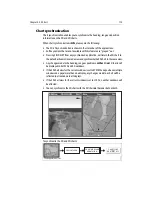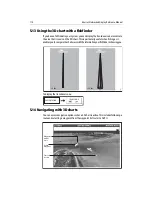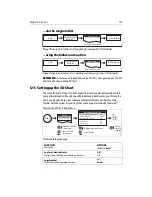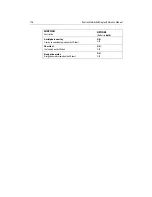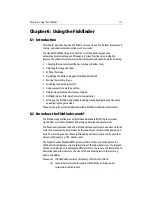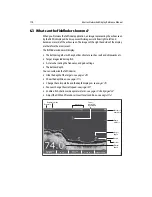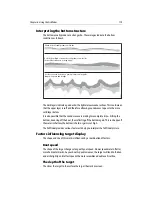
Chapter 6: Using the Fishfinder
117
Chapter 6: Using the Fishfinder
6.1 Introduction
This chapter describes how the Fishfinder uses sonar to see fish, bottom structure and
texture, and underwater obstructions such as wrecks.
The standard fishfinder image is a historical, scrolling bottom graph at an
automatically selected range and frequency. Various functions are provided to
improve the underwater view, select what is displayed and sound an alarm including:
• Changing the view displayed (Zoom, A-Scope or Bottom Lock).
• Adjusting the range and zoom.
• Shifting the image.
• Simplifying the bottom image and isolating bottom fish.
• Pausing the scrolling image.
• Switching the depth digit on/off.
• Using waypoints to mark a position.
• Determining depths and distances of targets.
• Fishfinder alarms (fish, depth or water temperature).
• Setting up the fishfinder application including manually adjusting the frequency
and adjusting the gain values.
Note:
Please refer to the Installation Guide for fishfinder calibration information.
6.2 How does the Fishfinder work?
The fishfinder application uses a Digital Sounder Module (DSM) to process sonar
signals from a suitable transducer and provide a detailed underwater view.
The transducer located on the bottom of the boat sends pulses of sound waves into the
water and measures the time it takes for the sound wave to travel to the bottom and
back. The returning sound echoes are affected by bottom structure and by any other
objects in their path, e.g. fish, wrecks, reefs.
The Digital Sounder Module (DSM) processes these echoes and sends data to the
fishfinder which displays a visual interpretation of the underwater view. The strength
of echoes is indicated on the display by different colors. You can use this information to
determine the bottom structure, the size of fish and other objects in the water e.g.
debris, air bubbles.
Notes: (1)
The DSM will operate at a frequency of 50 kHz or 200 kHz.
(2)
Some transducers will also enable the fishfinder to display water
temperature and/or speed.
Summary of Contents for E120W
Page 1: ...E Series Networked Display Reference Manual Document number 81244_2 Date March 2006...
Page 22: ...6 E Series Networked Display Reference Manual...
Page 48: ...32 E Series Networked Display Reference Manual...
Page 194: ...178 E Series Networked Display Reference Manual...
Page 200: ...184 E Series Networked Display Reference Manual...
Page 206: ...190 E Series Networked Display Reference Manual...
Page 226: ...210 E Series Networked Display Reference Manual...
Page 254: ...238 E Series Networked Display Reference Manual...
Page 272: ...256 E Series Networked Display Reference Manual...
Page 276: ...260 E Series Networked Display Reference Manual...











